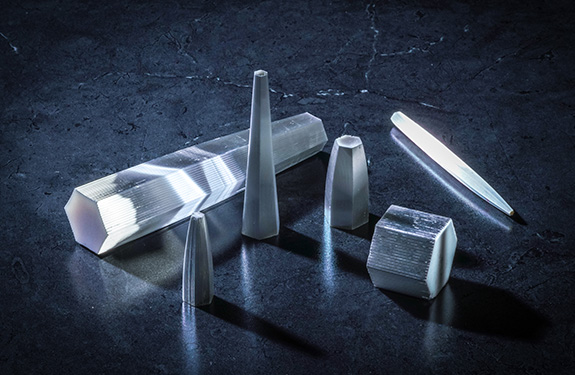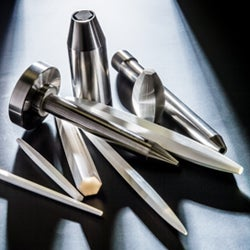- Analyzers
- Optics & Sources
- Technologies
- Support
- About
Maximizing Polycapillary Optic Performance: Choosing the Perfect X-ray Source and More
Dr. Ning Gao
Maximizing Polycapillary Optic Performance: Choosing the Perfect X-ray Source and More
Dr. Ning Gao
Dr. Ning Gao
Polycapillary X-ray optics are potent tools in X-ray analytical systems where small X-ray beam size, high X-ray flux density, and parallel X-ray beams are desired for various applications. To maximize the X-ray performance benefits provided by polycapillary optics, it is essential to choose the right X-ray source to optimize the system’s performance.
But what characteristics and performance specs of X-ray sources should a user consider when pairing them with the optics? Here are the five most important things to consider when choosing an X-ray source to pair with a pollycapillary optic.

The transmission efficiency of a polycapillary optic strongly depends on the X-ray source. This is because the optic has a small field of view and can only “see” X-rays from a small area at its input focus. The impact of X-ray source size on the optic performance is most noticeable for high-energy X-rays as the field of view of the optic gets smaller when the X-ray energy gets higher.
For typical analytical X-ray applications, an X-ray source size of 100 - 200 μm is a good choice when balancing the optic performance, maximum power loading of the X-ray tube, compactness, and economic considerations. For example, XOS’ fleX-Beam uses a 90 μm X-ray tube and delivers excellent overall performance at a low cost.
To fully take advantage of a small X-ray source size, as discussed above, the input end of the optic needs to be placed close to the source to achieve a large collection angle. Most modern microfocus X-ray tubes have reasonable access distance, typically 10-30 mm, which should allow the optic to get close enough to achieve optimal performance. From a practical point of view, the user also needs space between the X-ray source and the optic for other accessories such as safety shutter and primary filters. A general guideline when deciding the optimal input focal distance of a polycapillary optic is to match the input focal spot size of the optic to the X-ray source at the X-ray energy of interest. It is therefore always preferred to have the X-ray source access distance shorter than this optimal input focal distance.
Related: The Evolution of Polycapillary Optics
While a small X-ray source size is preferred when coupling an X-ray tube with a polycapillary optic, it is crucial to consider the maximum power loading on the X-ray tube. In most applications, the ultimate goal is to achieve the highest possible Xray intensity at the output of the optic.
The rule of thumb of maximum power loading for any sealed X-ray tubes is 1 watt per 1 μm. That means a small-spot X-ray tube will have lower maximum power loading than a large-spot X-ray tube. When combining the transmission efficiency of the optic and the X-ray tube’s maximum power loading, one may find that the smallest X-ray source size may not be the best choice from a system design perspective. XOS has a powerful simulation tool that enables optimal optic design at the system performance level, and customers are welcome and encouraged to participate in the design process.
Get in touch with one of our experts
A polycapillary optic captures a large solid angle of X-rays from an X-ray source and redirects them to a micron-sized focal spot or a highly collimated beam. The X-ray intensity achieved with such optics is a few orders of magnitude higher than that obtained with conventional pinhole collimators, contributing to the significantly improved X-ray analysis performance in detection sensitivity, spatial resolution, measurement speed, and precision. XOS optics are widely used in commercial instruments and customized X-ray analysis systems for various industrial and research applications in the fields such as microelectronics, semiconductor manufacturing, pharma, and life sciences.

A polycapillary optic must be precisely aligned with an X-ray source to achieve maximum performance. The perfect alignment condition can be impacted when the X-ray source drifts in position, mostly likely due to the anode temperature variation and the design of the X-ray tube.
While the small source position drift is not an issue for most conventional X-ray systems, it is noticeably impactful for the stability of the output beam from a polycapillary-based system. For example, a source drift of 20 μm could make the output intensity from the optic drop as much as 10%. While the position stability of the X-ray tube may not even be listed as the key spec in today’s market, the user should keep it in mind when choosing an X-ray tube.
A polycapillary optic-based system can be used for various applications, with XRF and XRD being the most popular and accurate. For XRF applications, there is no requirement for the divergent angle of the output X-ray beam, leaving the X-ray tube choice up to the user. While a microfocus X-ray tube is always preferred, a conventional X-ray source with a relatively large source size can still work well for the XRF application with noticeable performance enhancement compared to a nonoptic system.
For an XRD system using a polycapillary optic, the technical requirement for the X-ray tube is even more important, especially when a small parallel output beam is required. The close coupling between the optic and the X-ray source also becomes critical.
In conclusion, selecting the right X-ray source is pivotal to optimizing the performance of a polycapillary optic system. Factors such as source size, access distance, maximum power loading, position stability, and specific application requirements must all be carefully considered to achieve the desired analytical outcomes effectively. Partnering with our team of experts not only ensures optimized system design and performance, but also offers invaluable guidance. For more information and personalized assistance, connect with one of our experts and explore how their solutions can elevate your X-ray analytical applications.

Dr. Ning Gao has over two decades of experience in advanced X-ray optics, particularly in polycapillary X-ray optics. He works closely with XOS customers, from leading OEMs (original equipment manufacturer) in material testing industry to end users from universities and national labs in pioneering research fields, to find the optimal solutions for their application needs.
As a globally recognized expert in X-ray optics and their applications, Dr. Gao is active in analytical X-ray industry community and in collaboration with top scientists on many pioneering research and development projects including the PIXL instrument on the recently launched Mars Perseverance Rover.
If you'd like to get in touch with Ning or one of our other experts, click here.

